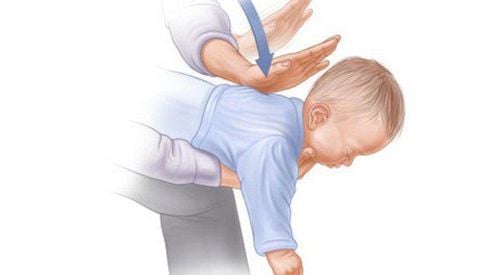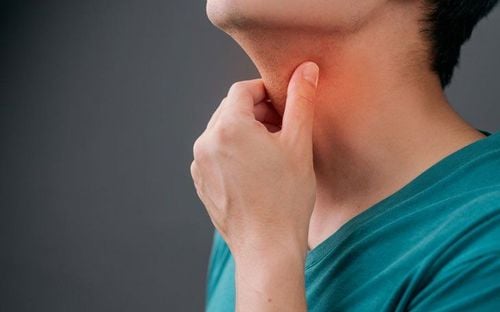This is an automatically translated article.
The article was professionally consulted with Doctor of Pediatrics - Neonatology - Vinmec Nha Trang International General Hospital.Foreign body is a common accident in young children, the handling is not too difficult, however, not everyone knows how to give first aid to children. Even the wrong first aid can make the condition worse.
1. Risks for children to choke on foreign objects
There are many causes of foreign body choking in young children, which are mainly due to the negligence and lack of control of adults:Children are too young to distinguish objects from food, so have a habit of putting small objects in their mouths. Children choke due to eating foods such as fish bones, chicken bones, hard nuts, seeds like longan, litchi, rambutan, ... Children often like to eat jelly jelly, this is a soft food, slippery, easy to slip into the throat before chewing. Children eat while playing, crying, leading to choking, choking on food.
2. Diagnosing a child with a blocked airway
Early detection of a child's airway obstruction caused by a foreign body is extremely important. Parents need to think of a foreign body in the airway when the child is playing, eating, suddenly has symptoms such as: cough, choking, cyanosis, difficulty breathing, choking, rolling eyes, may try to cough, spit to expel foreign body out. This condition may only be transient and then resolve on its own when the foreign body has been removed, but if not treated promptly, the child may stop breathing and die soon after.
Biểu hiện trẻ bị nghẹt đường thở
3. Common mistakes in first aid for choking foreign bodies
Many parents make the mistake of giving first aid to a child with a foreign object, making the baby's condition not resolved but even worse, common first aid methods such as:Putting hands or other objects in the mouth children to pull out the foreign body: This can be dangerous for the child, because the foreign body can go deeper, if using another object to pull out the foreign object, it can cause the foreign body to go deeper, or scratch the throat mucosa. . Stroking the chest: Whenever a child chokes or chokes, many people often stroke the child's chest, but this is the wrong way to do it because it can make the foreign body go deeper into the airway. Using some folk tips such as: for children to swallow rice, fruit, ... this can make the situation of choking on foreign bodies become more serious.
4. What to do when a child chokes on a foreign object?
To prevent children from choking on foreign objects, keep small objects out of the reach of children, cut food into small pieces, and always keep an eye on children, especially those under the age of 5.When detecting or suspecting that a child is choking on a foreign object, it is necessary to be very calm, do not use your hands or any object to pull the foreign object out of the child's mouth because it is not sure to remove it, but sometimes push the object deeper. Moreover, the throat hook can lead to vomiting, the child inhaling the vomit is even more dangerous.
If the child is still awake, does not have difficulty breathing, can still cry or speak, encourage the child to cough and quickly take the child to the nearest medical facility for a doctor to check, if it is true, the airway will be blocked. safely removed.
If the child shows signs of cyanosis, severe difficulty breathing, stops breathing, cannot cry, cannot speak, after calling an ambulance, it is necessary to conduct first aid promptly while waiting for the vehicle to arrive.

Sơ cứu trẻ bị hóc dị vật
Place the baby in a low head position on one of your arms or thighs. Open your baby's mouth with your finger and tap the middle of the baby's back with the heel of your hand 5 times between the shoulder blades. Check between each pat to see if the baby is choking. If obstruction persists, turn the infant over, giving chest compressions 5 times with two fingers at 1⁄2 below the sternum. With each chest compression, check to see if the choke is open. If the child is still choking, hit him on the back 5 times alternating with firm pressure on his chest 5 times until emergency services arrive. For older children:
Ask the child to bend over and pat the back of your hand firmly and firmly between the child's shoulder blades. Before clapping again, check to see if the choke has been cleared. If the choking is still not resolved, after slapping 5 times use chest compressions. Place one hand in the center of the child's back and the other in the center of the child's chest. With the breast of the hand resting on the chest, press the chest down 5 times - similar to cardiopulmonary resuscitation (CPR) but slower and more definitive. After each chest compression, check to see if the choke has been cleared. If the child is still choking, call 911 and then perform 5 back blows and 5 chest compressions alternately until paramedics arrive. Once the first aid steps have been taken, it is important to check that the airway is clear by:
Watch chest movement Listen to breathing sounds and feel the breath. After the first aid steps, if the choking foreign body is removed, it is still necessary to take the child to the hospital for a thorough examination, in case there may be a foreign body left.
In short, choking on foreign bodies is a common accident in young children. Parents and caregivers need to be very careful with objects around their children, especially small and hard objects, because young children may confuse toys with food, absolutely do not let children eat and play at the same time. , do not yell at the child to cry when eating because it can cause choking. When feeding children meat, fish should remove all bones to avoid choking bones. If the child accidentally chokes on a foreign object, parents need to be very calm, call an ambulance and in the meantime, apply first aid measures as instructed above.
Please dial HOTLINE for more information or register for an appointment HERE. Download MyVinmec app to make appointments faster and to manage your bookings easily.













